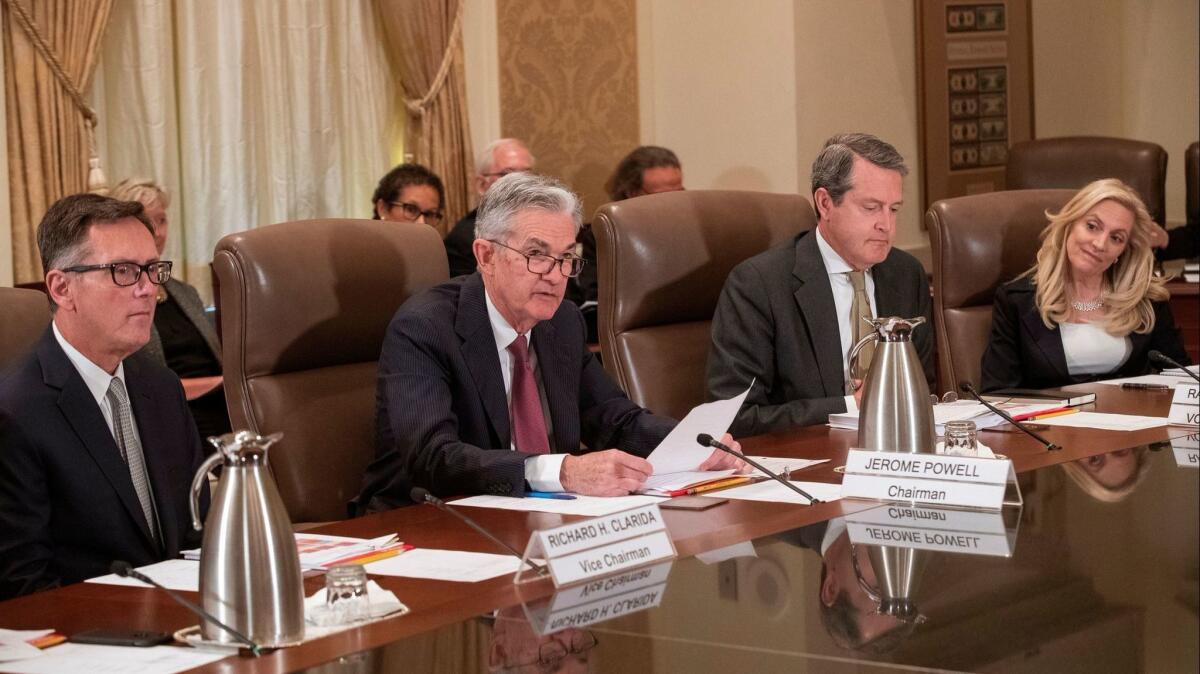Fed votes to ease rules for banks that are not seen as big enough to take down financial system

Federal regulators on Wednesday proposed a revised approach to overseeing banks seen as unlikely to pose a threat to the financial system — a step meant to limit the strictest rules only to the largest financial firms.
The Federal Reserve voted 3 to 1 to begin a formal rulemaking procedure that would establish a system of regulatory tiers separating megabanks considered systemically important, such as JP Morgan Chase and Citibank, from smaller but still large regional lenders, including U.S. Bancorp, Capital One Financial Corp. and PNC Financial Services Group Inc.
“The proposals before us would prescribe materially less stringent requirements on firms with less risk, while maintaining the most stringent requirements for firms that pose the greatest risks to the financial system and our economy,” Fed Chairman Jerome H. Powell said in a statement.
The moves are part of the Trump administration’s broader push to revisit bank rules it believes are overreaching. Critics of the changes say they dial back regulations intended to prevent a repeat of the 2008 financial crisis.
The proposals from the Fed — portions of which will be issued jointly with the Office of the Comptroller of the Currency and the Federal Deposit Insurance Corp. — follow a congressional vote this spring to soften rules put in place by the 2010 Dodd-Frank law for the smallest banks.
Community banks were freed from mortgage rules if they make fewer than 500 mortgages a year. And banks with less than $10 billion in assets were exempted from complying with the Volcker Rule, which prohibits institutions from trading for their own profit and limits ownership of risky investments.
And about two dozen banks with assets of as much as $250 billion were freed from Dodd-Frank’s mandatory stricter regulatory oversight. The legislation raised the threshold for that oversight, which includes rigorous annual stress tests, from $50 billion.
The proposal from the Fed on Wednesday further fleshed out those regulations for banks with up to $250 billion in assets by creating a system of tiers that will have banks evaluated on not only total assets, but also their dependence on riskier short-term funding, the scale of off-balance sheet exposures and how much business they do outside the United States.
For banks with between $100 billion and $250 billion in assets, including SunTrust Banks Inc., KeyCorp and Fifth Third Bancorp, the regulators plan to significantly reduce demands for how much easy-to-sell assets they keep on hand for a funding emergency. They’d also be put on a two-year cycle for stress tests.
Banks above $250 billion or smaller firms with higher risk factors would have some tougher demands tailored to how complex they are. But those that aren’t systemically important would have a much-reduced liquidity requirement.
The asset threshold for the toughest level of regulation would be raised significantly. Current rules say the category includes lenders with at least $250 billion in assets or $10 billion in foreign exposure, but the proposal would raise those levels to $700 billion or $75 billion in international activity.
The same eight banks known as globally systemically important financial institutions occupy the top of five new categories, retaining the same compliance expectations.
Northern Trust Corp. would be the sole firm in a lower regulatory category that still includes stringent regulations. Foreign banks weren’t addressed in the proposals, and the regulators said they intend to follow up “in the near future” with a new system for those firms.
Fed board member Lael Brainard, a Democrat who was appointed by former President Obama and was at the agency during the approval of many post-crisis bank regulations, voted against the proposals. She said the rules would go far beyond what Congress called for in the recent Dodd-Frank revisions and would “weaken the buffers that are core to the resilience of our system.”
The financial regulators appointed by President Trump are gaining momentum in addressing some of the long-standing complaints bankers have had with the government’s response to the 2008 financial crisis.
On Tuesday, the agencies proposed new capital standards for financial derivatives meant to answer industry concerns that banks have been forced to maintain more capital than they needed against holdings of those complex financial instruments. Unlike Wednesday’s effort, that one could have a significant benefit for large Wall Street firms.
The agencies also have been working to reshape the Volcker Rule’s limits on banks investing with their own money, and the Fed has been working on overhauling its capital rules, leverage demands, stress-test expectations and requirements for so-called living wills that plan how each lender would go bankrupt without hurting the broader financial system.
The latest proposal to relax rules for mid-sized banks will be open for public comment. The Fed also said it and the FDIC will soon propose a way to further tailor the submission of living wills.
Los Angeles Times staff writer Jim Puzzanghera contributed to this report.





